CROPS IN JAPAN
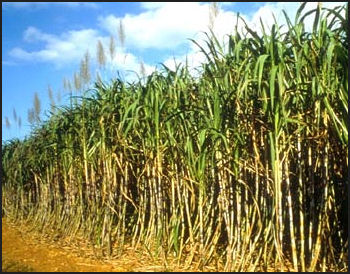
sugar cane in Okinawa Major crops: rice, sugar beets, vegetables, fruit. In much of Japan vegetables can be grown year round. Among those that grow well in the winter are potatoes, sweet potatoes, cabbage, taro, carrots, and a variety of turnips and radishes.
To prevent overproduction and keep prices at reasonably high levels vegetables such as cabbage, onions, lettuce, carrots and daikon are often destroyed. The preferred method for vegetables is on-the-spot disposal in which tractors crush the crop while it still in the field with the crushed vegetables becoming compost and fertilizer. Some criticize the policy as wasteful but the government insists on continuing the practice because they have yet to find reasonable alternative.
Tendo in Yamagata prefecture is famous for cherries’so much so that it was targeted by thieves who made off with 143 kilograms of cherries worth ¥470,000. In 2007, 30 police officers disguised as farmers and tourists took up positions in the area to thwart other thieves.
A farmer in Toyama Prefecture grew a pumpkin weighing 530.9 kilograms in 2008. The world record is 644.3 kilograms.
Large amounts of sugar cane are grown in Okinawa and Kagoshima Prefectures. The crop in 2012 was one of the worst on record as a result of drought and typhoons. . The crop in Okinawa Prefecture that year was estimated to be about 650,000 tons, down by 20 percent from 820,000 tons in the previous season. The figure for Kagoshima Prefecture is believed to be about 510,000 tons, down from 650,000 tons. [Source: Yomiuri Shimbun, May 1, 2012]
“According to the ministry, the number of sugarcane farming households in the nation currently totals about 26,500. The average income of each household was only 1.18 million yen in 2010, including aid from the central government and other sources.
Websites and Resources
Links in this Website: AGRICULTURE IN JAPAN Factsanddetails.com/Japan ; CROPS IN JAPAN Factsanddetails.com/Japan ; RICE FARMING IN JAPAN Factsanddetails.com/Japan ; LIVESTOCK IN JAPAN Factsanddetails.com/Japan ;
Good Websites and Sources on Agriculture: Good Photos at Japan-Photo Archive japan-photo.de ; Ministry of Agriculture, Forestry and Fisheries maff.go.jp/e ; Statistical Handbook of Japan Agriculture Chapter stat.go.jp/english/data/handbook ; 2010 Edition stat.go.jp/english/data/nenkan ; News stat.go.jp Agriculture Statistics, Japan nationmaster.com ;30-page Google E-Book: Agriculture in Japan (1918) books.google.com/books Agriculture and Food — Japan (2003) ; earthtrends.wri.or ; 30-page Google E-Book: Agriculture in Japan (1918) books.google.com/books ; Tree Hugger article on “Japan’s Amazing Rice Fields and Farms” treehugger.com/
Good Websites and Sources on Crops and Food: Japan Guide japan-guide.com ; Japanese Vegetable Dishes on About.com /japanesefood.about.com ; Growing Japanese Vegetables gardenguides.com ; Wikipedia article on Japanese Fruits Wikipedia ; About.com pictures of Japanese Fruit japanesefood.about.com ;Matsutake Mushrooms matsiman.com ; Swedish Site on Raising Matsutake Mushrooms in Japan goliatmusseron.blogspot.com ; Wikipedia article on Shiitake Mushrooms Wikipedia ; Green Tea Good Photos at Japan-Photo Archive japan-photo.de ; Japanese Green Tea www.o-cha.com ; Japanese Green Tea Online japanesegreenteaonline.com ; teanobi.com
Good Websites and Sources on Rice Farming: Traditional Rice farming in Japan lasr.net/travelarticles ; Rice Cultivation Photos japan-photo.de ; Photos of Rice Terraces ne.jp/asahi/aoyagi ; Rice Terrace Agriculture tokyofoundation.org ; Wikipedia article on Japanese Rice Wikipedia ; Essay on Rice and History aboutjapan.japansociety.org Japanese Rice Culture worldcom.ch/negenter ; Tree Hugger article on “Japan’s Amazing Rice Fields and Farms” treehugger.com/ ;Rice Farming and Greenhouse Gases gsfc.nasa.gov ; Mapping Paddy Rice Agriculture neyshtadt.ru
Genetically-Modified Food in Japan
Japan has blocked the import of GM foods. The Japanese are suspicious of genetically-modified food. In a survey in 1999, 80 percent of Japanese said they "reservations" about eating GM foods and 92.5 percent supported mandatory labeling. An anti-GM food movement is gaining strength. Laws that went into affect in 2001, required genetically-modified food to labeled as such and thoroughly tested. Some companies have announced they would no longer GM products.
Although no genetically modified crops are grown in Japan for commercial purposes, either as food for human consumption or for animal feed, it is estimated that 80 percent of the 20 million tons of the corn, soybean, cotton and oilseed rape Japan imports every year is genetically modified. "Transgenic organisms have never destroyed an ecosystem, and we're fully confident about the safety of GM crops," said Fumitake Fukutomi, chief of the secretariat of the Council for Biotechnology Information Japan, a Tokyo-based organization comprising six biotechnology companies.
“However, according to an opinion survey conducted by the Cabinet Office in 2007, 59.7 of the respondents cited "concerns over safety of genetically modified crops" among anxieties they had about technological advances. Nobuyoshi Nakajima, chief of the Ecosystem and Heredity Research Laboratory of the National Institute for Environmental Studies, said: "GM crops whose safety has been confirmed by reliable bodies can definitely be considered harmless as food.
Daikon
Large white carrot-shaped radishes, called “daikon”, are Japan's favorite vegetable in terms of planted acreage. Cheap and sold throughout the year, they can be truly massive — as thick and as long as a man's arm and weighing several kilograms. They are easy to grow and harvest and flourish in the winter. Many farmers plant it in the autumn and harvest in the winter or spring. It is said the best tasting are harvest at dawn in frosty mornings in January and February.
More than 100 different kinds of daikon radishes have been grown in Japan. Most are long and thick but there also round varieties. Aokubi daikon, which vary in size and thickness from a rolling pin to a bowling pin, account for 95 percent of production. The tastiest ones are said to come from the Miura Peninsula south of Tokyo where is said that ocean breezes enrish them with minerals.
Radishes made their way to Japan from China via Korea. It is not known whether radishes originated in Asia or evolved from Mediterranean varieties that were brought eastward on the Silk Road. Radishes have neem eaten for at least 5,000 years. They were among the rations eaten by the builders of the pyramids in ancient Egypt.
The Sakurajima daikon, grown along the Nagara river in central Honshu, is one of the heaviest vegetables in the world. It can reach a length of 1.5 meters and weigh 20 kilograms or more. About 90 percent of the white radishes eaten in Japan are of the “aokubi”, or green neck varieties. They are known for juicy meaty, relative sweetness and suitability for grating, boiling and pickling
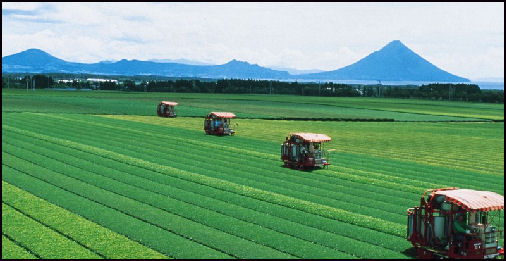
tea in Kagoshima Prefecture
Tea in Japan
Japan is a major tea producer. Much of the world's tea is harvested on plantations called "estates" or "gardens." Many of these have ski-tow-like ropeways and chutes that are used to carry leaves to where the leaves are processed. The tea industry is a labor-intensive business driven by thousands of peasants who pluck and dry the leaves are paid very little — often less than $1 a day — but usually live in free housing in crude dormitories on the estate where they work, and they are given free medical care and education. .
Tea bushes are grown from cuttings or seeds. They take about four years to mature. When they are six to 18 months old they are planted in a the plantation and when they get a little bigger they replanted into their permanent spot in a row at the plantation about four feet apart. About 3,000 plants grow in hectare of land.
Tea grows best on sloping terrain. Tea plants on mountains and hills rest on carefully constructed terraces that trap water and prevent erosion. Sometimes trees are planted for shade and windbreaks. Plants grow in low regions are ready to harvest after three years. Plants grow in high regions are ready to harvest after five years.
Tea Harvesting
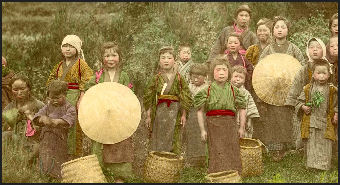
19th century tea pickers Tea is almost exclusively hand picked. In most parts of the world the work is done by women. Tea leaves have to be picked carefully. If they too big they are too tough; if they are too small they are not economically viable
The tea pickers pluck new and tender "flush" (two leaves and a bud). These flushes appear every seven or eight days in hot climates and around twice that long in cooler climates. Generally the buds near the end of a branch are considered to be the best quality. Lower quality one are found further down the branch. The flushes are flung over the shoulder of the pickers into baskets strapped onto their heads and backs. Good pickers pick around 160 pounds of leaves a day, from which about 40 pounds of finished eta is made.
Freshly picked leaves weigh about twice as much as correctly dried tea leaves. Skill and experience are needed to accurately judge their condition. It is difficult to produce a high quality tea. Some that do pick just one bud and two leaves from a single twig (many companies remove more leaves to increase production) and pick the leaves between 9:00am and 3:00pm when the leaves are in the best condition.
Tea Processing
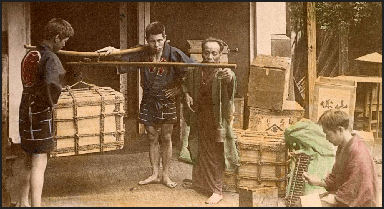
weighing tea in the 19th century Most tea is processed in large multistory buildings that often look like giant wooden sheds. The tea is often brought in by trucks, moved through the factory on conveyor belts and elevators. A factory may process 20,000 kilograms of leaves a day in the high season. This yields 5,000 kilograms of tea.
The final product is placed in large bags that are moved by truck, train or ship.
Green tea is put in a "steamer" and heated immediately after it is picked. This softens the tea for rolling. The tea is not fermented. The leaves are rolled and dried. Leaves that are made into black tea are “withered” (de-moisturized by blowing air through them) in a withering shed or upper story of the factory. Here, piles of leaves are set on hessian mat, nylon "tats," and withered by duct-blown hot air created by large machines with large fans and heaters. Withering removes moisture while leaving the leaves soft and pliable.
Next the tea is rolled in special machinery rather than crushed so that they aromatic oils that flavor tea are not destroyed. While being rolled the juice oozes for tea leaves and fermentation begins. After rolling the tea is fermented more by placing in a cool, moist room to accelerate oxidation, in the process turning the tea from green to bright copper. The length of their fermentation process determines how much oxidation takes place, which in turn determines whether the tea is green, black or oolong or another variety.
During the next stage the tea is dried or “fired” for 15 to 25 minutes. For black teas, the copper leaf turns black as carefully controlled driers reduce water content to 3 percent. The key — and the tricky part — to producing good tea is stopping fermentation and cutting off oxidation at precisely the right time. Finally, the “made tea” is sorted and rated into commercial grades, ready for shipment. The grades are determined both by size and quality and the elevation they are grown. Different sizes are sorted using machines with trays that shake the tea.
Shiitake Mushrooms
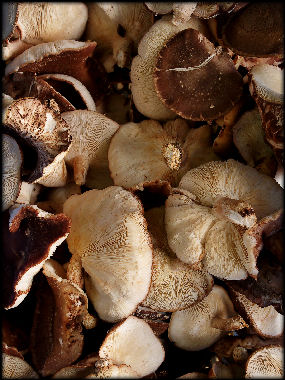
About 376,000 tons of mushrooms were produced in 2000, up from 279,000 tons in 1990. Among the different kinds of mushrooms found in Japan are “shimeji” (with fingernail-size caps and sold in clusters) and “enoki” (very long and stringy white mushroom with pea-size caps).
Shiitake are brown mushrooms that sell for about $2 to $5 a bag at supermarkets. They are the most popular mushroom in Japan. In the wild they grow on mildly rotted logs and tree trunks, preferably the beech family. Commercially grown ones are grown on mushroom farms that consist of oak logs stacked inside a coppice forest.
In recent years the domestic production of shiitake has declined due to the flow of low-priced imports from China. The industry is also in decline because farmers are getting too old (their average age is over 60).
Oita is Japan’s largest domestic producer of shiitake mushrooms, producing about a third of Japan’s Shiitake harvest. It produced 1,300 tons in 2007, down from a peak of around 4,000 tons in 1984.
The wholesale price of Shiitake peaked at ¥6,812 per kilogram in 1983 before dropping to around ¥2,000 in the late 1980s when imports from China really began having an impact. With prices that low domestic production slumped. Things did not really recovering until the late 2000s, with prices reaching ¥4,859 per kilogram in 2008. The rise was tied to worries about the safety of food from China. Imports of Chinese shiitake mushrooms were around 7,000 tons in 2007, down from 9,000 tons in 1997.
Growing Shiitake Mushrooms
Japanese shiitake producers use a technique called “cultivation from withered logs” while Chinese producers employ the “fungus bed” method in which they inject nutritional supplements into hardened sawdust.
The mushroom log farming technique was developed in the 1930s. In the spring holes are drilled in oak logs that have dried for three or four months. Small dowels which have been impregnated with shiitake mycelium (fungi) are placed in the holes.
Shiitake mushrooms appear twice a year: in the spring and autumn. It takes more than a year for the fungi to spread throughout the log so that logs planted with fungi do not produce a crop of mushrooms until the following autumn. After that the logs produce several crops a year for several years.
Large scale growers keep their logs in plastic-sheet greenhouses with carefully-controlled temperature and humidity. Some farms don't use logs at all but grow the mushrooms in compacted blocks of sawdust. These mushrooms however have a thinner skin and lack the delicate smell of the oak-grown mushrooms.
Matsutake Mushrooms
Matsutake mushrooms is an autumn delicacy in Japan and are regarded by some people as the world’s most delicious mushroom. Sort of like the truffles of the East, they sell for $300 an ounce. Their delicate aroma is regarded as especially pleasant. In the fall department stores sell baskets of ten mushrooms for between $80 and $160 depending on the size and quality of the mushrooms.
Matsutake mushrooms can be not be cultivated on farms. They grow in the wild in large stands of red pine in Japan, Korea and China and have been introduced to the American Northwest, Europe and Canada.
Chinese-produced matsutake mushrooms are about five to ten times cheap than Japanese-produced ones, selling for ¥1,380 for a 90 gram box with two or three mushrooms. Even so sales of Chinese-produced mushrooms have plummeted over concerns about food safety. Matsutake mushrooms are also imported from North Korea, Sweden and Canada. The Canadian ones cost about the same as mushrooms from China.
Growing Matsutake Mushrooms
Matsutake only come out in the autumn, The conditions for ideal matsutake growth are not well understood but this much is known: After matsutake spores fall to the earth they infect the roots of akamatsu red pines and other trees. The spores grow and spread and eventually turn the soil whitish and create white patches. Four or five years after this happens mushrooms appear. [Source: Kunio Kobinata, Yomiuri Shimbun]
Akumatsu trees between 30 and 70 years old are said to be best for growing matsutake, When white areas appear they expand in a circle. When mushrooms appear they can be harvested from the same spot for up to 40 years.
The problem is that events rarely unfold so simply and neatly. Less than 1 percent of matsutake spores germinate. Moreover matsutake fungus dies if it comes in contact with certain substances in the soil such as mold. Sewing spored by hand almost never produces mushrooms. Only one matsutake mushroom been raised in laboratory conditions and it only grew to the size of a tip of a person’ pinkie.
Production of matsutake mushrooms declined from 2,800 tons in 1960 to just 70 tons in 2008. One of the main reasons for the decline has been the degeneration of akamatsu forests. In the old days people used to clear the forests creating conditions suited for matsutake growth. These days people do this much less and consequently matsutake have trouble growing in soil that has been nourished with nutrients from too much decaying vegetation.
A farmer in Nagano Prefecture who raises matsutake in a 25 hectare forest told the Yomiuri Shimbun he carefully monitors soil conditions and air temperatures. He said a soil temperature of 19 degrees is best for producing sprouts and the forest should have some broad-leaf trees to create shade conditions ideal for mushrooms. He said that perhaps the most important thing is making sure the akamatsu trees are healthy and allowed to grow in a natural state. In Kyoto Prefecture, retirees have developed a large tract of akamatsu forests into matsutake growing areas and are having success coaxing mushroom out of places they didn’t grew before.
Matsutake Mushroom Production
Japanese-grown matsutake mushrooms are highly valued for their delicate flavor. They are produced mainly in Okayama, Hiroshima and Yamaguchi Prefectures, with some especially tasty ones coming come from Kyoto’s Tamba region. Poaching of matsutake mushrooms is a problem in some places.
In 2008, Japan imported 1,329 tons of matsutake mushrooms, mostly from China, South Korea and northern Europe.
Mushrooms cultivated from a blending of matsutake and shiitake mushrooms have been cultivated and are sold in department stores. They are 80 percent cheaper than matsutake mushrooms but taste almost like the real thing. Eringi are a kind of mushroom with a taste similar to matsutake. They can be cultivated in bottles.
Commercial producing matsutake is as much of holy grail for horticulturists as producing truffles commercially. Japanese scientists have developed a fungal bed capable of producing Matsutake mushrooms. Shuicho Aaono, a researcher at Yamagata University, has had the most success. Through a trial an error process he worked out a way for the mushroom spawns to develop into mushrooms.
The usual matsutake harvest is about 10 tons a year nationwide. Because the weather was bad the yield was only around three tons a year in the early 2000s. The year 2005 — in which 64.8 tons of matsutake mushrooms were produced — was particularly good year due to favorable summer rains and cool, autumn days.
Low matsutake harvests and higher than usual prices result from a lack of rainfall and cool summer temperatures. But not always. The sizzling heat wave in the summer of 2007 caused the leanest harvest of home-grown matsutake mushrooms since World War II. The high temperatures and lack of summer rainfall prevented the the mushroom’s fungal thread from growing. Wholesale priced reached ¥50,000 per kilogram, 50 percent higher than the previous year, with single mushrooms selling for as much as ¥20,000 and a box of four large mushrooms selling for ¥50,000.
Image Sources: 1) Okinawa Convention and Visitors Bureau 2) JNTO 3) 4) Visualizing Culture, MIT Education 5) Ray Kinnane 6) Jun from Goods from Japan
Text Sources: New York Times, Washington Post, Los Angeles Times, Daily Yomiuri, Times of London, Japan National Tourist Organization (JNTO), National Geographic, The New Yorker, Time, Newsweek, Reuters, AP, Lonely Planet Guides, Compton’s Encyclopedia and various books and other publications.
Last updated March 2012
